21 Types of Tulips to Grow at Home (With Pictures)
-
Greg Iacono
- Last updated:
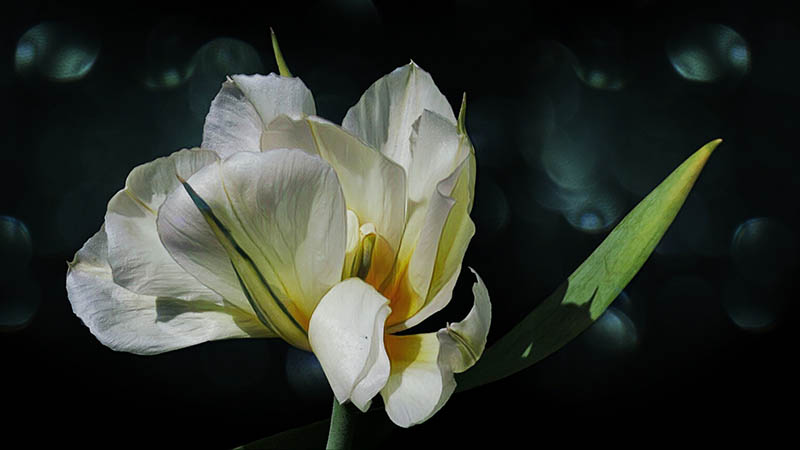
There’s no denying that tulips are one of the most beautiful flower species. If you think you know tulips, think again! There are over 3,000 registered varieties of tulips in a wide range of striking colors. You can grow tulip varieties quite easily to brighten your home, make your garden look amazing, and add major curb appeal to your yard. Whether you’ve got a green thumb or not, anyone can grow beautiful tulips at home! The biggest challenge is choosing which ones!
Most tulips bloom in the spring, so there’s no better time than the present to prepare. To help, we’ve put together a list of the 21 types of tulips to grow at home, along with beautiful pictures of each. Read on to discover them all and decide which lovely tulip varieties you’ll grow next spring!

The 21 Types of Tulips to Grow at Home
1. Burgundy Lace Tulip
| Season: | Mid to late spring |
| Conditions: | Full sun, well-drained soil |
| Height: | Up to 26 inches |
| Zone: | 3 to 8 |
The Burgundy Lace tulip is named after its deep burgundy wine color. The petals on this beautiful tulip are finely ruffled or fringed like lace, giving it a look and color that will stand out in your garden or on your dining room table.
Burgundy Lace tulips have one of the strongest stems of all the tulip species and look amazing in tall, delicate vases. They also can take wind and rain with few problems and love to grow in the full sun. One last aspect you’ll love about the Burgundy Lace tulip is that it lasts quite long after being cut to make your arrangements truly stand out.
2. Double Ice Cream Tulip
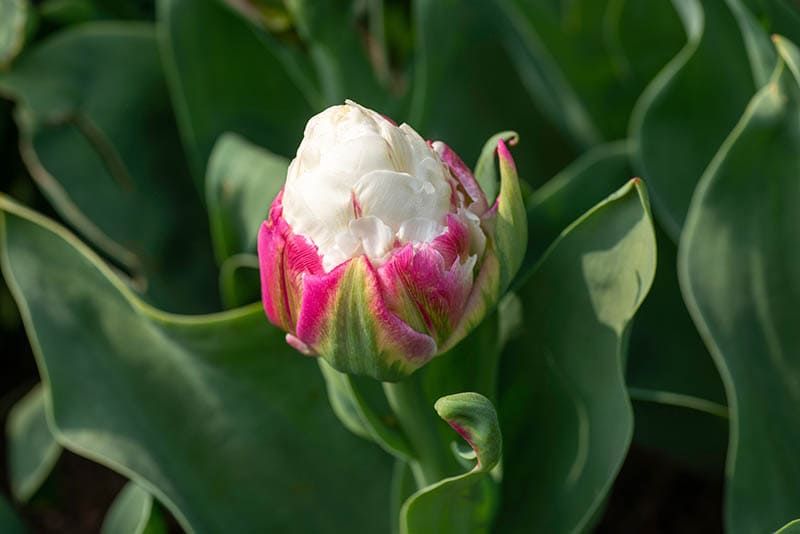
| Season: | Mid to late spring |
| Conditions: | Full sun to partial shade |
| Height: | 10 to 16 inches |
| Zone: | 3 to 9 |
These tulips are truly spectacular to see because they look like they were just ordered at your local ice cream shop! Once cut, you’ll be pleased to find that the Double Ice Cream tulip lasts for upwards of 2 weeks, and its short but strong stem keeps it fully upright.
Although they look delicious, eating these tulips is not recommended, but putting them in your garden in full to partial sun will add a splash of fun color. Double Ice Creams have one of the biggest tulip blooms when fully open!
3. Red Riding Hood Tulip
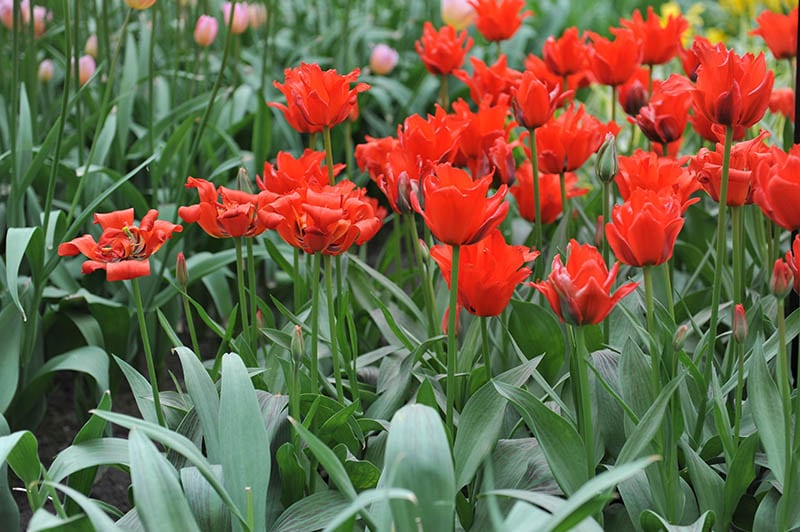
| Season: | Mid spring |
| Conditions: | Full sun, well-drained soil |
| Height: | Up to 10 inches |
| Zone: | 3 to 8 |
The Red Riding Hood Tulip is a Greigii hybrid, considered one of the most charming of the many varieties of this lovely flower. Although Greigii tulips are on the short side, their incredibly bright red bulbs add a blast of color to any bouquet. When fully opened, the dark center of the Red Riding Hood tulip adds even more color, and they last long after being cut.
Be sure to place them where they will be well-drained in your garden for best results. Also, when cutting, leave some leaves on the stems, which are especially attractive.
4. Grand Perfection Tulip
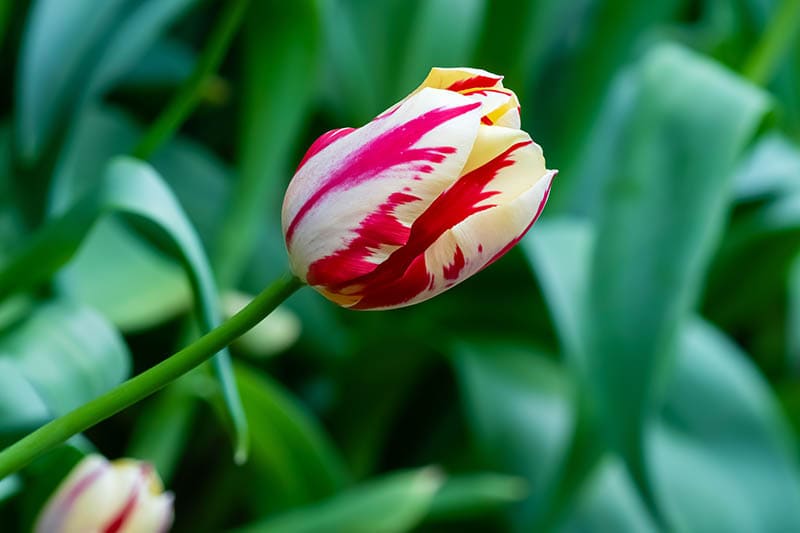
| Season: | Mid spring |
| Conditions: | Full sun to partial shade |
| Height: | 15 to 18 inches |
| Zone: | 3 to 8 |
Your spring garden will love the shot of spectacular color it gets from the Grand Perfection tulip! This tulip is a tall variety with solid stems and makes a perfect vase flower. The colors, a combination of creamy white and dark red, look striking in their effect, like flames licking up the side.
Flames or not, it’s recommended to plant the Grand Perfection tulip in partial shade, so they don’t burn. Also, it would help if you let a few leaves remain on the stems for a fuller bouquet, as these tulips last a long time.
5. Big Smile Tulip

| Season: | Late spring |
| Conditions: | Full sun, well-drained soil |
| Height: | 26 inches |
| Zone: | 3 to 8 |
The Big Smile tulip is one of the more iconic varieties, with large yellow flowers that look amazing in a bouquet or table arrangement. You’ll want to plant quite a few Big Smile tulips in your garden as, when they bloom together, they add a mesmerizing dash of bright color.
These tulips are also one of the tallest at 26 inches, making them perfect for placing alone in a tall, sleek and slender vase. Mixing Big Smile tulips with several other types is also a wonderful, colorful idea. Their stems are very strong also and allow this tulip variety to handle wind and rain with few problems.
6. Parrot Tulip
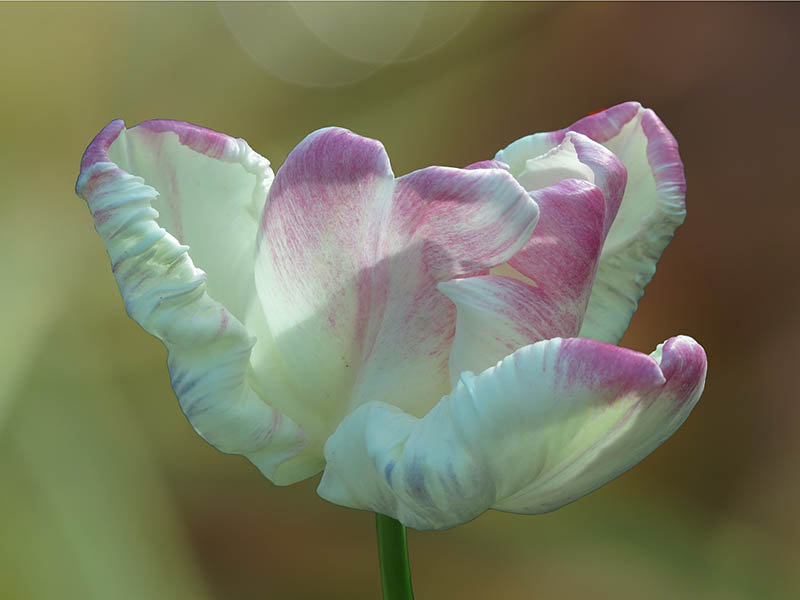
| Season: | Mid to late spring |
| Conditions: | Full sun |
| Height: | 28 inches |
| Zone: | 3 to 8 |
If you’ve ever seen the stunning colors of a parrot up close, you’ll instantly know why Parrot tulips got their name. With a wonderful, almost magical mix of colors in every bloom, Parrot tulips are unforgettable, and their fringed, lacy petals make them even more so.
You’ll find these lovely tulips in various colors, usually mixed. The word “exotic” is one of the best to describe them, as the Parrot is so different from the typical tulip. They are also larger than most tulips and add their intoxicating beauty to any flower display.
7. Lilac Wonder Tulip
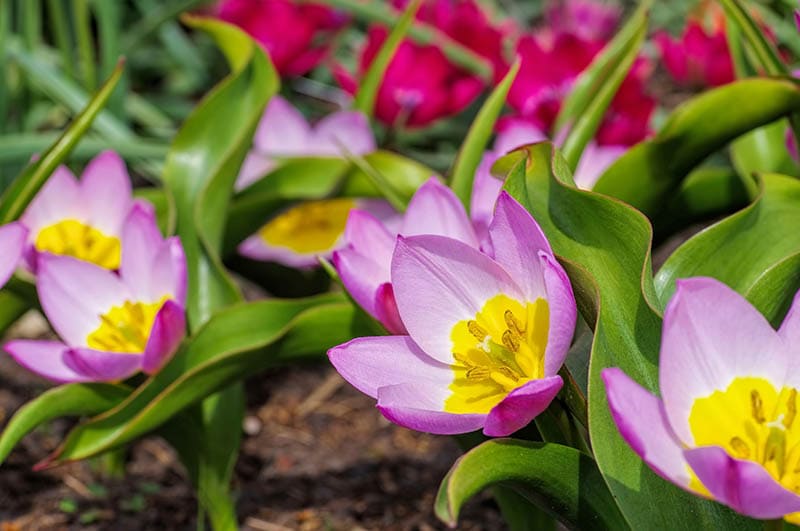
| Season: | Mid spring |
| Conditions: | Full sun and well-drained soil |
| Height: | 6 inches |
| Zone: | 3 to 8 |
As one of the shorter varieties of tulips, the Lilac Wonder is a delicate lilac color with a yellow center that’s bright and bold. One of the best reasons to give this tulip a special place in your garden is that it will produce more and more flowers every season when taken care of correctly.
When they do, and all the flowers bloom together, you’ll be glad you added the Lilac Wonder tulip to your menagerie of flowers and plants. One note is that the Lilac Wonder is one of the shorter tulip varieties at only 6 inches. It looks better in arrangements than in vases.
8. Fosteriana Tulip

| Season: | Early to mid-spring |
| Conditions: | 6 hours of bright sun daily |
| Height: | 10 inches |
| Zone: | 3 to 8 |
It used to be that the only way to enjoy the Fosteriana tulip was to travel to Central Asia. Today, however, you can enjoy these delicate flowers in your garden, where you’ll discover why they’re referred to as the “Emperor” tulip.
Relatively short at only 10 inches, the Fosteriana tulip has a strong stem and makes a fantastic vase flower. When open, they’re very fluffy, with cream and green flames shooting up their sides. They also have huge leaves, which will add plenty of foliage to your arrangements.
9. Queen of the Night Tulip
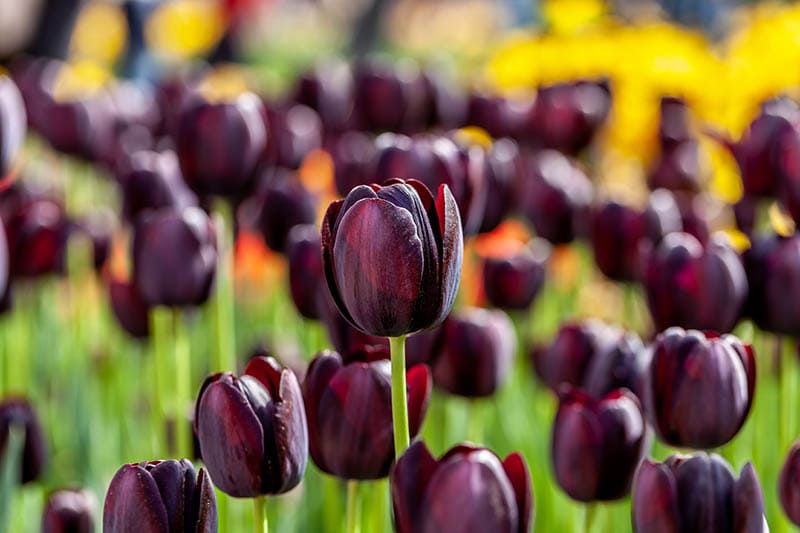
| Season: | Late spring |
| Conditions: | Full to partial sun, well-drained soil |
| Height: | 24 inches |
| Zone: | 3 to 8 |
Stunning, satiny, and luxurious are three words often used to describe the Queen of the Night tulip. They are also an all-time favorite among many home gardeners, and for a good reason; the Queen of the Night is by far one of the darkest varieties of tulips available.
If you need some flowers that provide a stark contrast in your arrangement or your garden, the Queen of the Night is a great choice. They can often be such a dark maroon color that some folks mistake them for being black. You’ll appreciate their strong stems and flowers that seem to be perfectly shaped.
10. Sunset Miami Fringed Tulip
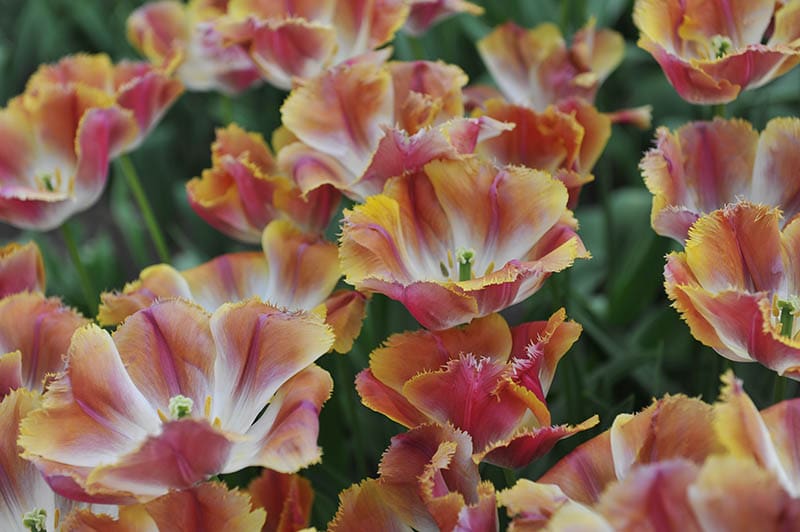
| Season: | Mid to late spring |
| Conditions: | Full sun to partial shade |
| Height: | 14 to 18 inches |
| Zone: | 3 to 9 |
If you’re a fan of delicately fringed flowers, the Sunset Miami Fringed tulip will be one of your favorites. Some growers refer to this type of tulip as “crispa” tulips, and they come in a variety of colors.
The fringe color typically contrasts with the flower’s base color, a sight to behold in a floral arrangement. Speaking of which, floral arrangements created with Sunset Miami Fringed tulips should feature the flower alone so that you can fully appreciate their intense and delicate beauty.
11. Tubergen’s Gem Tulip
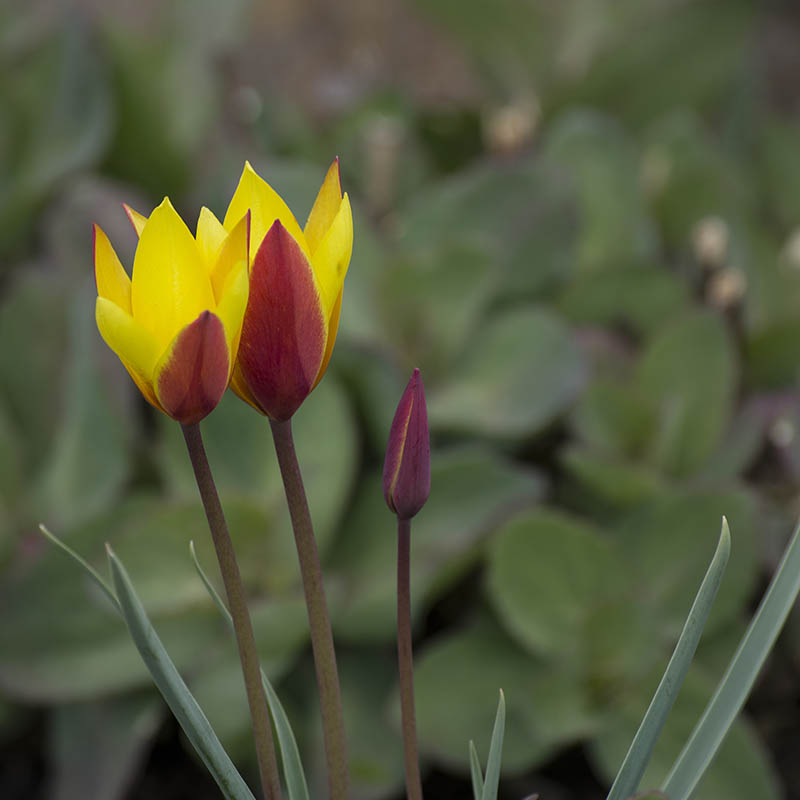
| Season: | Mid spring |
| Conditions: | Full to partial sun, well-drained soil |
| Height: | 10 inches |
| Zone: | 2 to 10 |
With a combination of rhodonite red with sulfur yellow, the Tubergen’s Gem tulip is one you and your family won’t soon forget! These tulips are often called “candlestick tulips” because they look like a candle with a lit flame on top! If you plant them in your garden, you’ll notice that every season.
That’s because they’re one of the most prolific naturalizing varieties of tulips; they spread out more and more every year. During the day, when the Tubergen’s Gem tulip is fully open, they look like gorgeous yellow stars. This variety also has strong, albeit short, stems that handle wind and rain well.
12. La Belle Epoch Tulip
| Season: | Late spring |
| Conditions: | Full sunshine |
| Height: | 24 inches |
| Zone: | 3 to 8 |
With a name like La Belle Epoch, you can be sure that adding this tulip to your garden will evoke plenty of romantic vibes. Many home gardening enthusiasts plant the La Belle Epoch tulip along walkways and paths to add a French countryside feel to their yards.
Planting them directly outside a window in a planter is also an excellent suggestion. One of the most distinctive facets of this lovely tulip is that it shoots up to 2 feet tall, making it one of the tallest tulip varieties! When fully open, the La Belle Epoch tulip will remind you of a full, frilly, and fantastic Victorian dress!
13. Persian Pearl Tulip
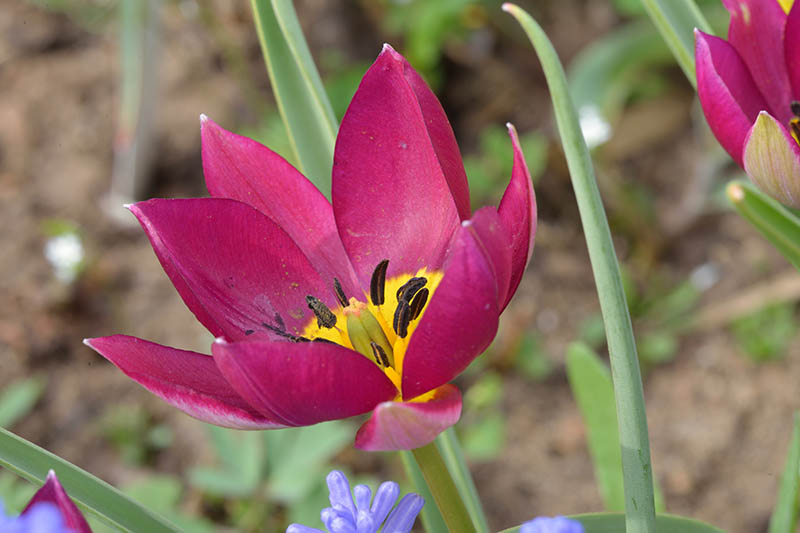
| Season: | Early spring |
| Conditions: | Full sun with well-drained soil |
| Height: | 4 inches |
| Zone: | 3 to 8 |
Introduced in 1975, the Persian Pearl tulip, like many tulip varieties, returns stronger every year after you plant it in your garden. You’ll love the dark magenta color of this tulip and the bright, golden-yellow center that’s visible when they open completely.
However, one minor drawback is that the Persian Pearl tulip only grows about 4 inches tall, so it’s not a great choice for tall vases. Many folks plant them around the periphery of their gardens to add a short, sweet color tracing as an outline. It should also be noted that, among tulips, the Persian Pearl is one of the most resistant to deer.
14. Peony Tulip

| Season: | Late spring |
| Conditions: | Partial shade with shelter from wind and rain |
| Height: | 10 to 16 inches |
| Zone: | 3 to 9 |
Peony tulips produce one of the biggest, fullest blooms of all the tulip types but only grow to 16 inches tall at most. For that reason, if you plant this delightful tulip in your garden, you might need to stake them to give their stems a little help.
Like peonies, the Peony tulip has almost never-ending layers of delicate petals that are sensitive to wind and rain. You can plant them in a somewhat sheltered spot or in between other plants that will support them. When it’s cut and displayed together in a tall vase, the Peony tulip is breathtaking and exceptionally lush.
15. Fancy Frills Tulip

| Season: | Mid to late spring |
| Conditions: | Full sun with well-drained soil |
| Height: | 16 inches |
| Zone: | 3 to 9 |
If you’re a hot pink and frills fan, the Fancy Frills tulip will be a delight! Also known as the Dallas Fringed tulip, their dazzling shades of pink with delicate, lace-like petals are sublime. When they open fully, the effect is stunning, as if someone with pruning shears and a lot of time on their hands went to work to give them a frilly trim.
The Fancy Frills tulip would look great with other pink flowers or against a backdrop of white tulips like the Double Ice Cream tulip. By the way, for all you romantics out there, the Fancy Frills tulip is said to represent eternal happiness and perfect love!
16. Rembrandt Tulip

| Season: | Late spring |
| Conditions: | Half sun and half shade |
| Height: | 26 inches |
| Zone: | 3 to 9 |
If you know art, you’ll immediately recognize the name of the Rembrandt tulip as coming from the famous Dutch painter. Rembrandt tulips come in a range of gorgeous colors, including purple with white, yellow with red, and several more. The streaks of color on the blooms are what you’ll love most. Amazingly, these streaks were caused by aphids, the insect bane of many home gardeners.
The aphids spread a virus among Rembrandt tulips, and the resulting “happy accident” gave them their distinctive look. Did Rembrandt ever create a painting with tulips? Sadly, he did not, but Holland is the worldwide home of this fascinating flower.
17. Angelique Tulip

| Season: | Late spring |
| Conditions: | Full sun and well-drained soil |
| Height: | 18 inches |
| Zone: | 3 to 8 |
The Angelique tulip is a smashing choice if you’re looking for a truly elegant tulip to plant at home. These tulips are graceful and have one of the largest blooms when open, up to 4 inches in diameter! With long, sturdy stems and an intoxicating fragrance, the Angelique tulip is a favorite to display in a sleek, tall vase.
In your garden, however, they should be planted where there’s some shelter because the blooms can suffer badly if they’re open when it rains. That’s why many gardeners prefer to plant them in containers and give them a coveted space on their patio or front porch.
18. Species Tulip
| Season: | Mid to late spring |
| Conditions: | Full sun |
| Height: | 8 inches |
| Zone: | 3 to 9 |
If you’re curious about what tulips looked like before they were bred and hybridized, the Species tulip will give you a good glimpse. Native to the Mediterranean, the Species tulip is the epitome of perennials, coming back stronger every year.
These are tough little flowers and can be planted where most others would fail to thrive, like rock gardens. Remember, though, that the Species tulip is on the short side at only 8 inches tall. Don’t plant them in the center of your garden, as they’ll be lost among taller plants and flowers.
19. Pink Impression Tulip

| Season: | Late spring |
| Conditions: | Full sun with well-drained soil |
| Height: | 22 inches |
| Zone: | 3 to 8 |
You’ll find that the Pink Impression tulip is one of the strongest of all the tulip varieties. That’s good news because the Pink Impression has one of the biggest blooms of all the many tulip varieties. Pink Impression tulips are a perennial cut flower favorite thanks to their long, strong stems and giant bulbs.
Their color, deep pink with a hint of purple, is a delight, so much so that they regularly make it into the Better Homes and Gardens test garden. Like many tulips on today’s list, the Pink Impression tulip naturalizes fast and comes back stronger every season.
20. Negrita Tulip

| Season: | Mid spring |
| Conditions: | Full sun with well-drained soil |
| Height: | 16 inches |
| Zone: | 3 to 8 |
If feathered and ruffled flowers float your boat, the Negrita tulip will have you happily sailing along in your home garden. This double-variety tulip is big, bold, and ruffled as a pirate’s shirt! Their color runs from a deep maroon to a dazzling pink, with several more in between, and their stems are durable and long.
That makes them a favorite for vase displays and also makes them very capable of standing up to wind and rain. The Negrita tulip is known to handle cold, do well in pots, and needs, like most tulips, a lot of sunlight. Once you get them started, the Negrita tulip grows easily and will return stronger every spring.
21. Yokohama Single Early Tulip

| Season: | Early spring |
| Conditions: | Full sun with well-draining soil |
| Height: | 18 inches |
| Zone: | 3 to 9 |
The last lovely tulip to grow at home on today’s list is the Yokohama Single Early tulip, and it’s a fitting one to end our article. One reason is that while most tulips have little or no aroma, the Yokohama Single Early tulip has a pleasant fragrance that will fill your kitchen or dining room.
These tulips are also one of the first to bloom in spring and are considered a herald of the season. Yokohama Single Early tulips last long after being cut and have a distinct, 6-petal bloom. Plant them this fall, and you’ll know spring has sprung next season before all your neighbors!

Tulip Growing Tips
While all tulips have subtle differences regarding where and how to grow them, they are all quite similar in some ways. For example, most of the tulips on today’s list need full sun and soil that drains well so that their dropper (a type of root system unique to tulips) doesn’t rot. Below are a few more tips for growing tulips successfully.
Plant the Bulbs in the Fall
You should plant tulip bulbs in the fall after the ground temperature has dropped below 60℉. If possible, you should have them in the ground before the first heavy frost of the season.
Plant Tulip Bulbs 6 Inches Deep
Planting tulip bulbs at the correct depth is critical, about 6 inches. Much higher or lower than that, and your resulting flowers might not be as strong as they should be. When you plant, add some fertilizer and make sure that your bulbs are at least 1 ½ inches apart.
Groups of 10 or more are recommended, as the more tulips, the more they can help and support each other when they grow and bloom in springtime. Once in the ground, cover them with soil and water your tulip bulbs well.
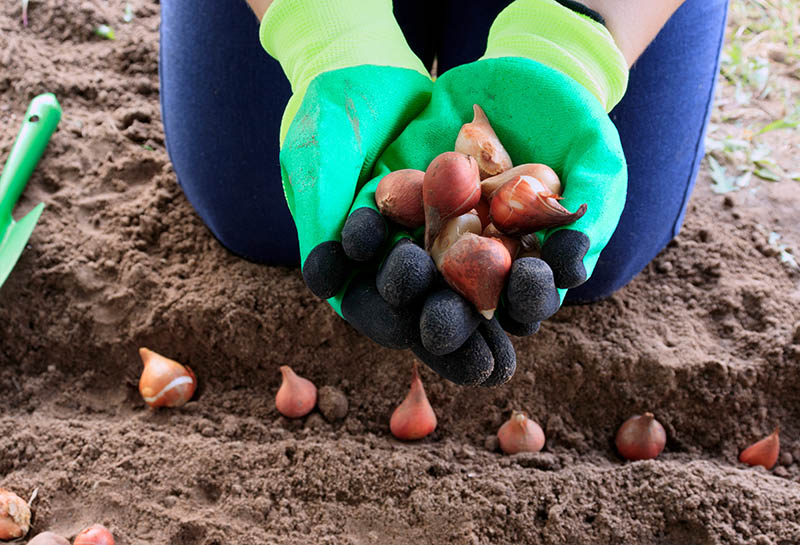
Keep the Soil Moist
While tulips need soil that drains well, they also need the soil to remain moist and not dry out. This requirement is especially true when your tulips bloom, as watering them and keeping the soil moist will help them last much longer.
Top the Tulip Bloom Before the Petals Fall Off
Topping a tulip means cutting off the bloom, which should be done towards the end of its life before the petals fall. Topping allows the bulb of the tulip to feed off the stem and become bigger and stronger. Also, don’t leave the blooms in your garden but discard them instead. Tulip petals left in your garden can cause disease.
Once the Stems Are Dry, Discard and Pull your Bulbs
After topping your tulips, let them be for about three weeks, but keep the soil moist. The bulb in the ground will keep growing, but the stems and leaves will dry out. Once they’re dry, cut them off and pull the bulbs out of the ground gently.
Store Your Tulip Bulbs in a Cool, Dry Place
After pulling your tulip bulbs, put them together in large paper bags and place them where they will stay cool and dry until fall. Then, replant them, water them and wait for your lovely tulips to bloom again next spring!

Final Thoughts
The 21 tulip varieties we focused on are only a handful of the 3,000 around the world, but all of them will grow well in your garden, pots, planters, and flower beds. Tulips are one of the easiest flower species to grow and, much to your delight, can be grown and regrown year after year. They add a rainbow of lovely colors to your garden and will be a joy to see when you’re gardening.
We hope you thoroughly enjoyed this look at the types of tulips to grow at home and that one or more of the tulips on our list is now your favorite. If you decide to grow some tulips of your own this year, best of luck!
See also: Great Tips on How to Store Tulip Bulbs (4 Simple Ideas)
Featured Image Credit: Radfotosonn, Pixabay
Contents
